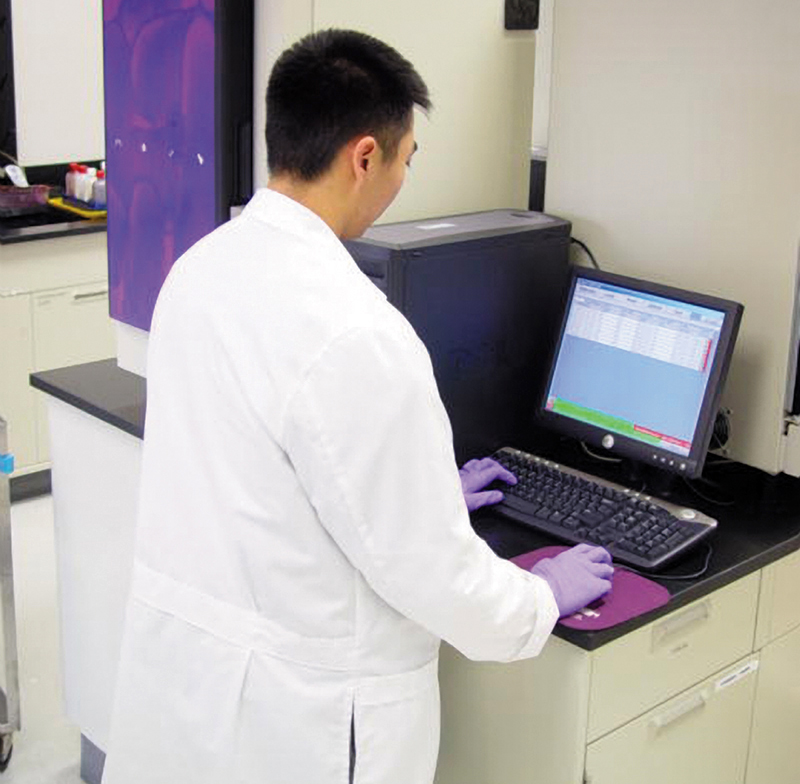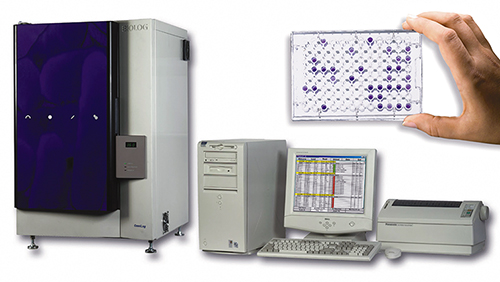
Discovering New Drugs on the Cellular Level
Originating Technology/ NASA Contribution
With the Vision for Space Exploration calling for a sustained human presence in space, astronauts will need to grow plants, while in orbit, for nourishment that they will not receive from only consuming dehydrated foods. As a potential source of food for long-duration missions, space-grown plants could also give astronauts an important psychological boost, as fresh vegetables could serve as a welcomed change from monotonous meals consisting of reconstituted foods in plastic bags. Even more, these plants could likely aid in the recycling of air and wastewater on spacecraft.
With a helping hand from a company by the name of Biolog, Inc., NASA is studying the impacts of decreased gravity and spaceborne bacteria on the plants being grown for food in space.
With a helping hand from NASA, this very same company is creating powerful new cell- and bacteria-analysis tools for use in discovering and developing new drugs on Earth.
Partnership
From 1993 to 1997, Hayward, California-based Biolog received Phase I and II Small Business Innovation Research (SBIR) contracts from Kennedy Space Center to work with NASA in developing two technologies that are now in use by Biolog customers worldwide. The first technology, based on the company’s pre-existing assay kits, was a process created to monitor populations of microbes. Dr. Jay Garland, manager of the Life Support Group at Kennedy, was interested in using this process as a way of monitoring the health of hydroponic crops that would be grown in space during future manned missions to Mars. The second technology was an instrumented system that would allow automated monitoring of Biolog’s assay kits for NASA’s purposes. Together, these innovations intended to provide NASA with better means of growing food in space and avoiding a catastrophic crop failure during long-term space travel.
Product Outcome
Biolog went on to extend the technologies it developed with SBIR assistance from NASA in order to bring two novel and important cell-testing technologies to market: the Phenotype MicroArray and the OmniLog System.
Biolog’s Phenotype MicroArray technology is complementary to DNA microarrays and proteomic technologies, which allow scientists to detect changes in levels of genes or proteins that direct most cellular functions. By measuring the patterns of change in genes and proteins, scientists are attempting to correlate the findings with something important, such as a disease state. A major goal would be to understand the biochemical basis underlying a disease and gain insight into how to correct the problem. However, according to Biolog, there are typically hundreds to thousands of changes that are detected by these gene and protein analyses and it is often difficult to judge which ones are really significant to the cell.
“A big advantage we have with our Phenotype MicroArray cellular assays is that we are measuring change at the cellular level,” claimed Dr. Barry Bochner, Biolog chairman and chief scientific officer. “Proteomics and gene expression don’t necessarily give enough insight—often, you don’t really know what it means to the cell. The data we get is at a higher level in terms of information content and can be simpler to interpret.
”Because of this, the Phenotype MicroArray represents the third major technology that is needed in the genomic era of research and drug development, according to the company. Just as DNA microarrays and proteomic science have made it possible to assay the level of thousands of genes or proteins all at once, the Phenotype MicroArray technology makes it possible to quantitatively measure thousands of cellular traits (phenotypes) simultaneously, in both microbial and mammalian cells. Such measurements can be critical in determining the effects of genetic changes and drug exposure on cells.
In the field of drug discovery, the Phenotype MicroArray allows researchers to obtain a comprehensive picture of a drug’s effect on a specific cell. “People usually do this type of assay on cells in a rapid growth state, and they’re only looking at the cell under one state,” Bochner noted. “But a cell is always changing. With our technology, you can take a drug and get a very information-rich fingerprint of its effect on the cell under a wide range of physiological states.”
Incubation and recording of phenotypic data gathered from the Phenotype MicroArray are performed by the OmniLog PM System, an integrated system of cellular assays, instrumentation, and bioinformatics software. Just as it automatically monitored assay kits for NASA, the OmniLog technology monitors thousands of phenotypes simultaneously. Several times each hour, it captures digital images of the cell assays being studied and stores quantitative color change values as computer files. These files can be displayed in the form of kinetic graphs and up to 480,000 data points can be generated in a 24-hour period.
Another version of the OmniLog product, called the OmniLog ID System, can be paired with Biolog’s microbial-identification kits to easily and efficiently identify over 2,000 species of aerobic and anaerobic bacteria, yeasts, and fungi, virtually everything from A to Z (Achromobacter cholinophagum to Zygosporium mycophilum).
The principal customers for Biolog’s Phenotype MicroArray and OmniLog products are laboratories requiring state-of-the-art capabilities in cell-based assay and identification products, especially pharmaceutical, biotech, cosmetics, and medical device companies; university and government research laboratories; laboratories testing for diseases of humans, animals, and plants; laboratories performing environmental monitoring; and companies or organizations involved in production or testing of food and drink.
Applications of the NASA-funded technology continue to expand and evolve. Biolog recently announced that the Phenotype MicroArray and OmniLog products have been installed at the Lawrence Livermore National Laboratory, in Livermore, California, where genomics researchers are using the technology to understand and characterize phenotypes of bacteria strains that are considered potential bioterrorism agents. Other important government laboratories such as the U.S. Food and Drug Administration and the U.S. Department of Agriculture are also employing the technologies to better understand foodborne pathogenic bacteria and the spread of epidemics.
Additionally, Biolog is sharing its innovations with the Nara Institute of Science and Technology, in Japan, in an effort to broaden what is known about the functions of genes in the important bacterium E. coli. According to Tim Mullane, Biolog president and chief executive officer, “E. coli is one of the most studied model cell lines in the world, and despite the early sequencing of this organism’s genome, many of its 4,000 genes have no known function. Even where function is known, this information is often incomplete.”
Next on the list for Biolog is to broaden the technologies for use with human cells. The company will soon be releasing Phenotype MicroArrays that can assess the energy metabolism pathways in cells from different organs and tissues. This should aid studies in diabetes, obesity, and cancer.
Phenotype MicroArray™ is a trademark of Biolog, Inc.
OmniLog® is a registered trademark of Biolog, Inc

Biolog, Inc.’s product lines have been built upon patented technology that greatly simplifies testing of cells. Principal customers include pharmaceutical, biotech, and cosmetic laboratories, as well as laboratories testing for human, animal, and plant diseases.

A Biolog, Inc., laboratory technician performs cellular tests using Phenotype MicroArray assays and the OmniLog System. The technology is capable of monitoring thousands of phenotypes simultaneously.













